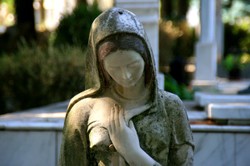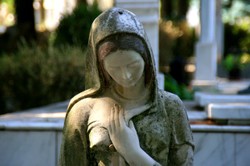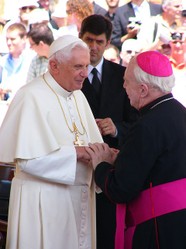In 1967 Adrienne , a much loved doctor and friend of the poor, died. She left behind many grateful people, poor patients whom she treated for free, and the step children of her two deceased husbands, who loved the childless woman who had cared for them, despite having no children of her own. She also left a series of mystical writings that have become more respected as the years have elapsed. In the cruel world of World War Two her religious faith stood out as a tremendous act of faith .In a world in which evil seemed triumphant.

Adrienne von Speyr a life on the edge of heaven
by frankbeswick
Swiss convert to Catholicism, doctor, step mother and mystic Adrienne von Speyr, 1902 to 1967, lived an extraordinary life in a world which often overlooked her uniqueness.
Early Years
Some individuals seem to been endowed from early age with religious sensitivity. Adrienne was one. Her childhood years contained some religious visions. She had occasional visions of angels, and when she converted to Catholicism at the age of thirty eight she told her confessor Urs von Balthasar, himself an accomplished theologian, that in childhood she had seen a figure on the stair case whom she now recognized as St Ignatius Loyola, founder of the religious order to which von Balthasar belonged, the Jesuits. At fifteen she had a vision of Mary, Jesus' mother, whom she described as the most beautiful person she had ever seen, an experience that would give her succour through many years. From early on she showed an interest in Catholicism, which was strangely out of kilter with the Protestantism of her family, which increasingly dissatisfied her spiritually, though she was close to an aunt who was a prayerful Calvinist.
Yet she had difficulties with her mother, who was a cold character who favoured the elder daughter over the strange and very religious Adrienne.. but her relationship with her father was strong, and he was a regular visitor to hospitals where he introduced her to medicine, a career that she was later to take up. It was in these early years that she sensed that she had a talent for succouring the sick. But when she was fourteen her father died, which meant that entry to university was harder to afford. She carried in at school taking additional courses in business at her mother's behest, as her mother saw her as a businesswoman rather than a medic. During her school years her strong personality shone out. She was popular among the other pupils, but could be firm and assertive. She publicly berated a teacher for not being fair in his statements about Catholicism. By that age, late teens, her Catholic sympathies were beginning to stand out.
Later on she accrued the money to attend university where she studied medicine. Besides being assertive about religious unfairness, she showed her mettle when a professor who had made a calamitous error that led to a patient's death tried to pin the blame on a young nurse. Outraged at the injustice, Adrienne organized a boycott of the man's lectures until he resigned. She could not stand injustice. She was critical of some of her medical colleagues, for she knew some to be dedicated doctors, whereas others she knew to be merely in medicine for the money. Her strong personality was manifest when she decided to become a Catholic, and her Protestant family were not happy. That did not stop Adrienne. She spoke to the Jesuit priest Urs von Balthasar who began instruction in the Roman Catholic faith and in 1938 at the age of 36 she formally joined the Catholic church. She knew that she was in the place right for her. Balthasar took the young doctor under his wing.
She also married for the first time.at the age of 27. It was less a union of sexual passion than a practical matter. She wanted children and he was a widower with two sons and needed a wife to look after them. She tried to have children of her own, but miscarried thrice. But when her husband died a few years later she was distraught, found it hard to pray and was troubled with thoughts of suicide. She later had another marriage, but apparently it was a sexless union. She till continued to care for the sons that she had taken on. They were devoted to the woman who had taken care of them.
Life as a Doctor
Very spiritual people seem to be empowered by an energy that enables them to do extraordinary things. These are not usually oddities such as yogic flying, but hard and sustained work. She was extremely hard working and sometimes saw sixty to eighty patients in a day in her consulting rooms in Basel. If the patients were too poor to pay she gave her services for free. She had a strong sense of empathy for the less advantaged of society, even in her student years. When unmarried women who had had children were in the delivery room she was always respectful to them and sensitive to their dignity, whereas some other staff were not, and this was extended as a widespread, long-established pattern of behaviour covering all the patients with whom she came into contact.
Adrienne had a deep conviction that she should treat the whole person from cradle to grave, and so she believed that she should accompany people in their final journey into death. This meant that she stayed with dying patients when she could, never giving up on them till they made their journey. This indicates that she did not advocate euthanasia, as she saw every minute of life as valuable. Years later. in 1967, as she lay dying, she took a positive attitude to her own death, saying "It is a beautiful thing to die." Her pro-life stance was evident in her absolute refusal to do abortions, and she backed this up with working to help women find alternatives to this option.
Yet her life was not exempt from suffering, as she had been a sickly child, had had three miscarriages, a heart attack two years after qualifying as a doctor, and could not have children, and when her husband died after seven years of marriage she went though a spiritual crisis, finding it hard to pray and she was disturbed by thoughts of suicide, but her faith and devotion to her stepsons and the help of priests, saw her through this dark night of the soul. She married again, but this was also a short lived period, as the next husband died too. She soldiered on, continuing to serve the children, the poor and the sick. Yet in 1945 she and her close friend and confessor Urs von Balthasar found it within their capacity to found a religious society, the society of St John, which they ran together, acting as joint superiors of this organization of lay people. She was already developing a close working relationship with Urs, and later when he found it necessary to leave the Jesuit order so that he could continue his work with Adrienne, which involved him in editing her spiritual writings and taking down what she wrote in religious trances, he moved in with Adrienne and her family, having a room in their house.
Mystical Writings.
There were some profound prayer experiences just after her conversion, but the critical experience came when she was driving home from her medical practice one night when a light shone in her car and a voice announced that from now on she would dwell in Earth and Heaven. The fact that a passer-by saw the light and thought that the car was on fire indicates that this was not an hallucination. From then on she began to have religious experiences, which she dictated to Urs. However, she kept a low profile where such experiences were confirmed and so she sought no publicity.
Balthasar was an ideal writing partner. He was a member of the Jesuit order, a highly intellectual order of priests who undergo a course of high academic study and he was no stranger to religious experience himself. While most priests get their vocation from a persistent nagging thought that God is calling them, he got his calling by a quasi-vocal experience of the divine, in which God called him to the priesthood. He was a theological writer in his own right and was a theologian favoured by John Paul the Second. He wrote significant works of theology over and above the sixty works that he took down and edited at the dictation of Adrienne. who, Urs considered, was the author of works more important than his own. Yet there is no comparison, for her theological works were unique to her, as his were to him. Her writings were more like accounts of visions, whereas he excelled at conceptual thinking. Balthasar was slightly younger than Adrienne, but lasted until 1988, dying at 83.
In 1954 Adrienne's already creaking health began to fade as she developed diabetes and arthritis. Her eyesight was already beginning to fail, so she could no longer drive to see her patients. She carried on writing as long as possible, but had to give up medicine. She spent her retirement writing , knitting and seeing her step children and their children, the latter of whom called her grandmother. Eventually her eyesight failed completely and so she needed to be cared for. She suffered about three years of blindness before dying in 1967. During her final years, which were a time when she suffered much physical pain she bore her illness with Christian fortitude, and regarded personal suffering as a spiritual education to make us compassionate to the sufferings of others. Besides her comment on how beautiful it was to die, her last words were "thankyou, thankyou, thankyou." Then she slipped quietly out of life.
She was to become a forgotten spiritual writer, but the elevation of Urs von Balthasar who was becoming a well-respected theological writer brought Adrienne's works to attention, and later John Paul the Second held a theological symposium to assess her works. She was accepted as a spiritual and theological thinker acceptable to the Catholic Church. The lay community that she and Urs founded still continues.
I am an Amazon associate and earn money from qualifying purchases on this page.
paid link
You might also like
The Shrine that Survived the ReformationThe destruction of the monasteries at the Reformation was total, and with the...
Walsingham: England's Marian shrineFounded in Anglo-Saxon times it was ruined at the reformation, but now is reb...
Benedict XVIYesterday the world said goodbye to a man of great scholarship and holiness.T...






 The North Wales Pilgrim Path28 days ago
The North Wales Pilgrim Path28 days ago
 Rewilding the Isle of the Thundergodon 02/17/2024
Rewilding the Isle of the Thundergodon 02/17/2024
 The Granite Kingdom: a Cornish Journeyon 12/29/2023
The Granite Kingdom: a Cornish Journeyon 12/29/2023
 Some Scenic Areas in Northern Irelandon 05/27/2022
Some Scenic Areas in Northern Irelandon 05/27/2022




Comments
Yes.Thanks
Yes she was. They use continental Portuguese. My daughter in law is Angolan, but she fled to Portugal but she fled to Portugal at three, so she grew up speaking continental Portuguese.
It might perhaps help your Portuguese to listen to an audio Bible.
WordProject is the site that I look to for listening in the non-English languages that I know to the Bible every Lent. It offers both Brazilian and continental Portuguese, each of which I joyfully plug into.
I reach the following site -- https://www.wordproject.org/bibles/au... -- through the search terms "Audio Bibles Other Languages."
You probably also would be interested in the above site's New Testament Greek and Latin recordings, correct?
My carioca (from Tupi-Guarani kari, "white man" and oka, "house" = name for Rio de Janeiro because founded and settled by Europeans) speech means that di, r and ti always are pronounced respectively djee, French r and tchee. But your in-laws and your wife might have no difficulty otherwise understanding me.
Would your daughter- and granddaughter-in-law and their birth families as well as your wife be speaking continental Portuguese or Portuguese African or a mix of the two?
Your wife would have been quite a linguistic help in Portugal, about which you wrote such a fascinating wizzley!
My wife is a bettervspeakerbof PortuguesebthannI am. You havebremindednmebto get a move on with the language.
The Nathan Pacheco performance got my attention because of my Brazilian Portuguese (actually the carioca speech of Rio de Janeiro).
The aforementioned tenor is of Portuguese ancestry and speaks Italian, Portuguese and Spanish as well as his native Unitedstatesian English.
It seemed something that should interest you because of your Portuguese-speaking daughter- and granddaughter-in-law.
A wonderful chatracter
Myl u tube is outbofibdate, btit I will try to get it. Thanks.
Frank,
What do you think of this performance of Be Thou My Vision by Nathan Pacheco
https://www.youtube.com/watch?v=ihJAJ...
I never connected Swiss with Catholic religion. Adrianne von Speyr was very inspiring woman, that's for sure.